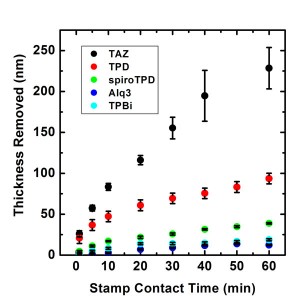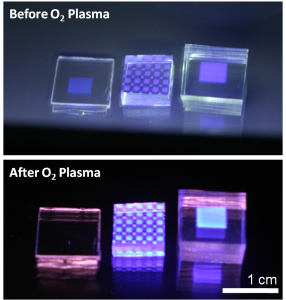Patterned Removal of Molecular Organic Films by Diffusion
Organic light-emitting diodes (OLEDs) and other optoelectronic applications employ molecular organic solids due to their high luminance, efficiency, and contrast ratio [1], but the shadow-masking technology currently used to pattern pixels at the finest level of feature definition requires thin, delicate masks, which are difficult to scale to large-area substrates [2]. Thin films of a variety of molecular organic materials can be patterned using a microcontact printing-based method in which relief-patterned polydimethylsiloxane (PDMS) stamps remove a controlled thickness of the vapor-deposited material without requiring elevated temperatures or applied pressure [3]. In recent work, we have investigated the mechanism of the previously reported subtractive patterning method. Experiments that vary the length of time the stamp remains in contact with a deposited film reveal the process to be time- dependent. Figure 1 shows the time-dependence measured for five different organic materials: TAZ, TPD, spiro-TPD, TPBi, and Alq3. Despite the differences in the absolute thickness removed, all the materials display similar behavior with respect to stamp contact time: patterning occurs to greater depths the longer the PDMS remains in contact with the organic film. The large amounts of material removed and the overall time-dependence suggest that the mechanism for the removal is not strictly due to adhesion of the organic to the PDMS stamp. These observations, combined with persistent photoluminescence of used stamps despite exposure to oxygen plasma (Figure 2), show that patterning occurs by diffusion of the organic dye molecules into the PDMS. The diffusive nature of the patterning process additionally makes repeated patterning with a single stamp possible, potentially enabling roll-to-roll or wave printing over large areas.
- Figure 1: Patterning of molecular organic films shows sensitivity to the time the stamp remains in contact with the film. Patterning through the film thickness can be achieved for combinations of film thickness and contact time that fall below the curves.
- Figure 2: Left to right: 20-nm spiro-TPD evaporated on SiO2, PDMS stamp used to remove 20-nm spiro-TPD, 20-nm spiro-TPD evaporated on PDMS. After O2 plasma exposure, the persistence of photoluminescence in PDMS indicates that dye molecules have diffused into the polymer.
References
- B. Young, “OLEDS-Promises, myths, and TVs,” Information Display, vol. 25, no. 9, pp. 14-17, Sept. 2009. [↩]
- H.D. Kim, H.J. Chung, B.H. Berkeley, and S.S. Kim, “Emerging technologies for the commercialization of AMOLED TVs,” Information Display, vol. 25, no. 9, pp. 18-22, Sept. 2009. [↩]
- J. Yu, “Improving OLED technology for displays,” Ph.D. thesis, Massachusetts Institute of Technology, Cambridge, 2008. [↩]

